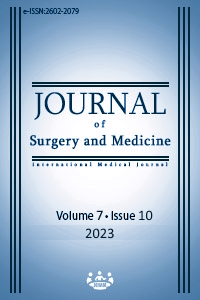ERCC8 related Cockayne syndrome type-1: A rare entity diagnosed in a Turkish boy
ERCC8 related Cockayne syndrome type-1
Keywords:
Cockayne syndrome, ERCC8 gene, novel variantAbstract
Cockayne syndrome (CS, OMIM #216400 and OMIM #133540) is a rare, progressive, multisystemic disorder that results in premature aging and cachectic dwarfism. It is an autosomal recessive disorder with a prevalence of 2-2.5 per million. Pathogenic variants detected in the ERCC excision repair 6 (ERCC6) and ERCC excision repair 8 (ERCC8) genes are responsible for molecular pathogenesis. In this case report, an 11-year-old boy with severe microcephaly, growth retardation, loss of subcutaneous fat tissue, neuromotor developmental delay, bilateral cataracts, and facial dysmorphism but without dermal photosensitivity, who had a novel missense variant in trans configuration with a nonsense variant is presented.
Downloads
References
Karikkineth AC, Scheibye-Knudsen M, Fivenson E, Croteau DL, Bohr VA. Cockayne syndrome: Clinical features, model systems and pathways. Ageing Res Rev. 2017;33:3–17. DOI: https://doi.org/10.1016/j.arr.2016.08.002
Kubota M, Ohta S, Ando A, Koyama A, Terashima H, Kashii H, et al. Nationwide survey of Cockayne syndrome in Japan: Incidence, clinical course and prognosis. Pediatr Int. 2015;57(3):339–47. DOI: https://doi.org/10.1111/ped.12635
Natale V. A comprehensive description of the severity groups in Cockayne syndrome. Am J Med Genet Part A. 2011;155(5):1081–95. DOI: https://doi.org/10.1002/ajmg.a.33933
Chikhaoui A, Kraoua I, Calmels N, Bouchoucha S, Obringer C, Zayoud K, et al. Heterogeneous clinical features in Cockayne syndrome patients and siblings carrying the same CSA mutations. Orphanet J Rare Dis. 2022;17(1):1–14. DOI: https://doi.org/10.1186/s13023-022-02257-1
Richards S, Aziz N, Bale S, Bick D, Das S, Gastier-Foster J, et al. Standards and guidelines for the interpretation of sequence variants: A joint consensus recommendation of the American College of Medical Genetics and Genomics and the Association for Molecular Pathology. Genet Med [Internet]. 2015;17(5):405–24. Available from: https://doi.org/10.1038/gim.2015.30 DOI: https://doi.org/10.1038/gim.2015.30
Cockayne EA. Dwarfism with retinal atrophy and deafness. Arch Dis Child. 1946;21(105):52–4. DOI: https://doi.org/10.1136/adc.21.105.52
Nance MA, Berry SA. Cockayne Syndrome: Review of 140 cases. Am J Med Genet. 1992;42(1):68–84. DOI: https://doi.org/10.1002/ajmg.1320420115
Wilson BT, Stark Z, Sutton RE, Danda S, Ekbote AV, Elsayed SM, et al. The Cockayne Syndrome Natural History (CoSyNH) study: Clinical findings in 102 individuals and recommendations for care. Genet Med. 2016;18(5):483–93. DOI: https://doi.org/10.1038/gim.2015.110
Spitz MA, Severac F, Obringer C, Baer S, Le May N, Calmels N, et al. Diagnostic and severity scores for Cockayne syndrome. Orphanet J Rare Dis. 2021;16(1):1–10. DOI: https://doi.org/10.1186/s13023-021-01686-8
Frouin E, Laugel V, Durand M, Dollfus H, Lipsker D. Dermatologic findings in 16 patients with cockayne syndrome and cerebro-oculo-facial-skeletal syndrome. JAMA Dermatology. 2013;149(12):1414–8. DOI: https://doi.org/10.1001/jamadermatol.2013.6683
Laugel V. Cockayne Syndrome Summary Genetic counseling GeneReview Scope. 2020;1–19.
Calmels N, Botta E, Jia N, Fawcett H, Nardo T, Nakazawa Y, et al. Functional and clinical relevance of novel mutations in a large cohort of patients with Cockayne syndrome. J Med Genet. 2018;55(5):329–43. DOI: https://doi.org/10.1136/jmedgenet-2017-104877
Downloads
- 377 959
Published
Issue
Section
How to Cite
License
Copyright (c) 2023 Sinem Kocagil, Ali Rıza Keklikci, Yusuf Aydemir, Oğuz Çilingir, Sabri Aynacı, Ebru Erzurumluoğlu Gökalp, Beyhan Durak Aras, Sevilhan Artan
This work is licensed under a Creative Commons Attribution-NonCommercial-NoDerivatives 4.0 International License.
















